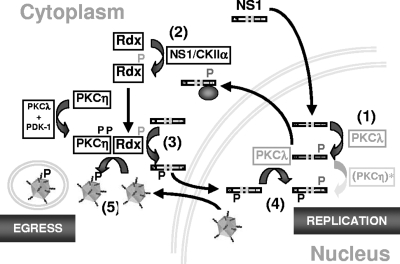FIG. 8.
Schematic presentation of the impacts of ERM proteins on the MVM replication cycle and of their regulation through NS1/CKIIα. Newly synthesized NS1 is transported to the nucleus, where it becomes phosphorylated by PKCλ (step 1), activating the viral polypeptide for helicase function and making it able to physically interact with CKIIα (step 2). In addition to PKCλ, NS1 requires PKCη-driven phosphorylations to promote viral DNA amplification. These modifications may occur rather inefficiently at early stages due to the presence of active PKCη in the nucleus. Upon synthesis of viral proteins, PKCη becomes activated through PKCλ and PDK-1 and translocates to the perinuclear region, colocalizing with activated Rdx, which might serve as an adaptor protein for PKCη. In MVM-infected cells, Rdx activation is dependent on CKII and is mediated through the NS1/CKIIα complex (step 2). This association of Rdx and PKCη in the perinuclear area leads to efficient phosphorylation and activation of newly synthesized NS1 on its way to the nucleus (step 3), where NS1 is also phosphorylated by PKCλ and becomes competent to drive viral DNA replication (step 4). The PKCη/Rdx connection also appears to be important for the phosphorylation of progeny virions during their transport from the nucleus to the cell periphery (step 5).

